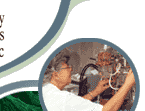| Research topics
In the center of our interest is the circadian timekeeping system of
mammals and its entrainment. Mammals, similarly to all other living
organisms, exhibit daily rhythms of biological variables at molecular,
cellular, organismal, functional and behavioral levels. The rhythms
exist even under nonperiodic conditions and are thus generated by an
endogenous clock, i.e., pacemaker. Under nonperiodic conditions, the
rhythms free-run with a period close to, but not equa1 to 24 hours.
Therefore, the rhythms as well as the pacemaker, which controls them,
are called circadian. Within the 24-h cycle, the rhythms are entrained
mostly by the light-dark cycle, namely by the light period of the day,
but other entraining agents may be also involved. The circadian
pacemaker is located in the suprachiasmatic nuclei (SCN) of
hypothalamus. According to biochemical, morphological and functional
characteristics, the SCN may be divided into two parts, namely into the
ventrolateral (VL) part, which receives photic input from the retina,
and into the dorsomedial (DM) part.
The aim of the studies performed in the Department is to elucidate
the dynamics and the mechanism of photic and non-photic entrainment of
the circadian pacemaker itself and of overt rhythms controlled by the
pacemaker. The research concentrates mostly on anima1 models, namely on
the rat, but human studies are also performed as well.
Main results
A. Anima1 studies
The VL-SCN exhibits a rhythm in the light induction of immediate
early genes, namely of c-fos mRNA and c-fos protein. We found that the
interval enabling high c-fos photoinduction in the VL-SCN depends on
previous day length, i.e., photoperiod, under which rats were maintained;
the effect of the photoperiod is not mediated by the endogenous
melatonin
signal. When the photoperiod changes from a long "summer" one to a short "winter" one, the
interval adjusts gradually to the change. In the DM-SCN, we have
described a rhythm in the spontaneous c-fos immunoreactivity in
darkness. Even the DM-SCN rhythm depends on the previous photoperiod
and adjusts gradually to a change from long to short days. Also, the
rhythm in mRNA for arginine vasopressin in the DM-SCN is
photoperioddependent.
Hence a functional state of both parts of the SCN is modulated by the
photoperiod. The whole SCN may thus serve not just as a daily, but also
as a seasonal clock. Under a regime with alternating periods of light
and darkness, the mechanism of the morning c-fos increase which may
indicate an increase in neuronal activity, is different in both parts of
the SCN: whereas in the DM-SCN the increase is spontaneous, in the VL-SCN
it is induced by light.
Rhythmicity of the VL- as well as of the DM-SCN may be reset by
photic stimuli administered during the subjective night. Preliminary
results indicate that the resetting may not proceed exactly in the same
way in the two SCN parts. The magnitude of the phaseshifts depends on
the photoperiodmodulated functional state of the SCN pacemacker.
Interva1 enabling photic resetting of the circadian rhythmicity is also
photoperiod dependent and resembles that enabling high c-fos
photoinduction; both intervals may thus represent a rhythm of
sensitivity to light. Also, nonphotic stimuli may reset the SCN
rhythmicity. Melatonin administered in the late day resets
instantaneously the evening rise in c-fos photoinduction. Melatonin
administered in the late night suppresses the morning c-fos rise in the DM-SCN
but it does not phaseshift the DM-SCN rhythmicity.
B. Human studies
Two overt rhythms controlled by the SCN, namely the salivary
melatonin and cortisol rhythm, were used as markers of the human
circadian rhythmicity. Exposure of human subjects to an actual natural
16 h summer photoperiod shortens the melatonin signal duration as
compared with the winter pattern followed under a combined artificial
and natural 16-h photoperiod. Summer days experienced from sunrise till
sunset thus evoke a true longday response of the human circadian system.
However, the compressed summer melatonin rhythm waveform extends rapidly,
following a shortening of the photoperiod. Hence the natural summer
photoperiod may mask a true waveform of circadian rhythms.
We reported earlier that a single exposure to bright light in the
morning phase advanced the human circadian system within a day. Now we
found that a fixed morning awakening coupled with lowintensity light
can maintain the advance. The human circadian system may be, however,
reset only by shifting of the sleep time under dim light at a time that
may occur commonly in everyday life, without any previous bright light
exposure. In collaboration with the lst Medical School in Prague we
found changes of the circadian system of patients suffering from
idiopathic hypersomnia as compared with control subjects.
Future prospects
Studies will continue to elucidate further the dynamics and
mechanisms of photic, photoperiodic and non-photic entrainment of the
mammalian circadian system. Attention will be concentrated on processes
in the two SCN parts induced by environmental stimuli, on the time
course of the processes and on the interaction between both SCN parts.
Besides expression of immediate early genes, expression of core clock
genes and clockcontrolled genes will be followed to understand the
molecular basis of action of the entraining agents. In human studies,
collaboration with the lst Medical School in revealing the function of
the circadian system in sleep disorders will continue. Knowledge of the
mechanisms of entrainment will allow us to propose a better therapy for
circadian and sleep disorders as well as ways how to prevent them.
Publications
|




